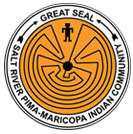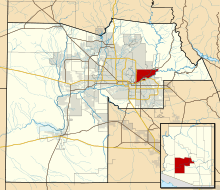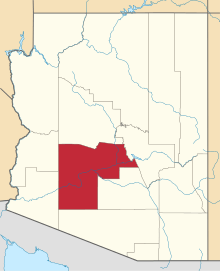Salt River Pima–Maricopa Indian Community
 | |
| Total population | |
|---|---|
| (9,357) | |
| Regions with significant populations | |
| United States (Arizona) | |
| Languages | |
| Akimel O’odham, Xalchidom Piipaash, and English | |
| Religion | |
| Traditional beliefs, Christianity | |
| Related ethnic groups | |
| other Akimel O’odham and Maricopa tribes, Tohono O'odham |


The Salt River Pima–Maricopa Indian Community comprises two distinct Native American tribes—the Pima (Akimel O'odham) and the Maricopa (Piipaash)—many of whom were originally of the Halchidhoma (Xalchidom) tribe. The community was officially created by an Executive Order of US President Rutherford B. Hayes on June 14, 1879. The community area includes 53,600 acres (217 km2) of which 19,000 remain a natural preserve. Today, they are a federally recognized tribe located in Arizona.
The community borders the Arizona cities of Scottsdale, Mesa, Tempe, and Fountain Hills.
The Great Seal of the Salt River Pima–Maricopa Indian Community is a representation of I'itoi, commonly referred to as the Man in the Maze.
Business enterprises
The community operates two casinos on its land, both operating under the "Casino Arizona" brand name; the facilities attract gamblers from the local Phoenix area as well as out-of-state tourists. There is also a limited amount of office development, and a major outdoor shopping center called The Scottsdale Pavilions (featuring national retailers), on the portions of tribal land closest to the northern business and financial districts of neighboring Scottsdale.
In February 2011, the community opened Salt River Fields at Talking Stick, the first Major League Baseball spring training facility to be built on Indian land in the nation. This 140-acre (57 ha) baseball complex is the spring training home of the Arizona Diamondbacks and Colorado Rockies.
The community owns and operates the Phoenix Cement Company, which supplies northern Arizona and Phoenix with cement and related products. The company's plant, one of only two large cement manufactories in Arizona, is in Clarkdale.[1]
The streets and roads in the community generally follow the same street grid of the surrounding cities in the Phoenix metropolitan area, such as Phoenix, Scottsdale, and Mesa; most are two-lane rural roads and are widened somewhat in certain spots to serve vehicular traffic for the casinos and other business enterprises.
Language
The Salt River Pima–Maricopa Indian Community supports the preservation of the Akimel O’odham and Xalchidom Piipaash languages through teaching and learning for everyone within the Community and encourages all Community members to preserve the Akimel O’odham and Xalchidom Piipaash languages within their homes (Council Resolution SR-2026-2000).
Some tribal employees, who work within the community, take language classes so they have a better understanding of the community and people and have a better working relationship with the people they serve. When children are no longer learning a language, that language is in serious trouble. Some learners want to fill that void in their experience of their own culture and they want to know more about who they are. Some want to learn so they can understand whether their aunts or parents are talking about them.
Extreme poverty, school dropout, drug use, and border issues hinder the progress of language revitalization as the resolution of these issues appears more important to tribal members. After all, the needs of the tribe must be met as problems are prioritized. The effort and extent of revitalization makes it more difficult to put before other issues. Language activists are looking to reverse the language endangerment in their community but a commitment to the goal is needed for them to continue.
Man in the Maze
Central to the beliefs of the Salt River Pima–Maricopa Indian Community is the story of the Man in the Maze, or I'itoi ki:k, which is the symbol seen on the great seal. This ancient pattern visible at the right is representative of the journey a person makes through life, including obstacles and problems. The figure is called Elder Brother and he is about to make his way through the maze where at the center, he will find the Sun God who is there to greet him and bless him into the next world. The symbol belongs to the Akimel O’odham (Pima), Pee-Posh (Maricopa), and Tohono O'odham tribes and is traditionally represented in petroglyphs and basket designs.[2]
Notes
- ↑ "Phoenix Cement: 50 & Growing". Verde Independent. Western News&Info. April 14, 2009. Retrieved March 20, 2013.
- ↑ Ramon-Sauberan, Jacelle "Several Tribes Share the Man in the Maze." Rez Net News. 15 Feb 2009 (retrieved 9 Sept 2010)
References
- Salt River Pima–Maricopa Indian Community, Community Council Resolution: SR-2026-2000, August 16, 2000
External links
Coordinates: 33°31′13″N 111°47′36″W / 33.52028°N 111.79333°W
